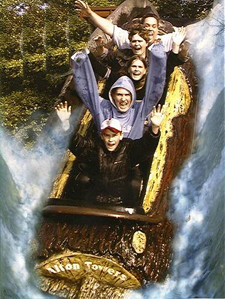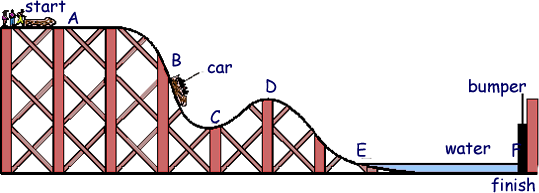Questions on Energy Transitions
Q5. The photograph shows some pupils in a log car on a theme-park ride.

The drawing below shows the ride. The letters A, B, C, D, E and F show different points along the track.

The car starts from A and travels to F, where it stops by hitting a bumper. At E the car enters a trench filled with water.
(a)
(i) At which two points does the car have no kinetic energy? Give the two correct letters.
A and F
1 mark
(ii) At which point does the car have the most gravitational potential energy? Give the correct letter.
A
1 mark
(iii) At which point does the car have some kinetic energy and the least gravitational potential energy? Give the correct letter.
E
1 mark
(b)
(i) The cars are not powered by a motor. What force causes the cars to move along the track from B to C?
The force of gravity or the weight of the car
1 mark
(ii) When a car splashes through the water at E, it slows down. What force acts on the car to slow it down?
Friction OR drag OR water/air resistance
1 mark
(c) Complete the sentence below by choosing from the following words.

When the car hits the bumper at F, its ........kinetic........ energy is transferred into .........sound.......... energy and ...........thermal...... energy.
3 marks
Maximum 8 marks









